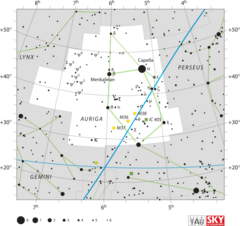Astronomy:Pi Aurigae
| Observation data Equinox J2000.0]] (ICRS) | |
|---|---|
| Constellation | Auriga |
| Right ascension | 05h 59m 56.09830s[1] |
| Declination | +45° 56′ 12.2761″[1] |
| Apparent magnitude (V) | 4.25[2] |
| Characteristics | |
| Evolutionary stage | asymptotic giant branch[3] |
| Spectral type | M3 II[4] |
| U−B color index | +1.83[2] |
| B−V color index | +1.72[2] |
| Variable type | LC[5] |
| Astrometry | |
| Radial velocity (Rv) | 0.71±0.76[6] km/s |
| Proper motion (μ) | RA: −3.987[1] mas/yr Dec.: −9.775[1] mas/yr |
| Parallax (π) | 4.1986 ± 0.4984[1] mas |
| Distance | approx. 780 ly (approx. 240 pc) |
| Absolute magnitude (MV) | −2.46[7] |
| Details | |
| Radius | 127+44 −11[1] R☉ |
| Luminosity | 4,257±564[1] L☉ |
| Surface gravity (log g) | 0.55±0.10[8] cgs |
| Temperature | 3,388±6[8] K |
| Metallicity [Fe/H] | 0.03±0.04[8] dex |
| Other designations | |
| Database references | |
| SIMBAD | data |
Pi Aurigae, Latinized from π Aurigae, is the Bayer designation for a single,[10] red-hued star in the northern constellation of Auriga. Located about one degree north of the 2nd magnitude star Beta Aurigae,[11] Pi Aurigae is visible to the naked eye with an apparent visual magnitude of 4.25[2] Based upon parallax measurements, it is approximately 780 light-years (240 parsecs) away from Earth.[1] At that distance, the brightness of the star is diminished by 0.54 in magnitude from extinction caused by interstellar gas and dust.[6]
Pi Aurigae is an evolved bright giant star with a stellar classification of M3 II.[4] After exhausting the supply of hydrogen at its core the star has expanded to approximately 127[1] times the girth of the Sun. It is classified as a slow irregular variable of type LC and its brightness varies from magnitude +4.24 to +4.34.[5] On average, the star is radiating 6,493[12] times the Sun's luminosity from its enlarged photosphere at an effective temperature of 3,388 K.[8]
References
- ↑ 1.0 1.1 1.2 1.3 1.4 1.5 1.6 1.7 1.8 Brown, A. G. A. (August 2018). "Gaia Data Release 2: Summary of the contents and survey properties". Astronomy & Astrophysics 616: A1. doi:10.1051/0004-6361/201833051. Bibcode: 2018A&A...616A...1G. Gaia DR2 record for this source at VizieR.
- ↑ 2.0 2.1 2.2 2.3 Johnson, H. L. et al. (1966), "UBVRIJKL photometry of the bright stars", Communications of the Lunar and Planetary Laboratory 4 (99): 99, Bibcode: 1966CoLPL...4...99J.
- ↑ Eggen, Olin J. (July 1992), "Asymptotic giant branch stars near the sun", Astronomical Journal 104 (1): 275–313, doi:10.1086/116239, Bibcode: 1992AJ....104..275E.
- ↑ 4.0 4.1 Morgan, W. W.; Keenan, P. C. (1973), "Spectral Classification", Annual Review of Astronomy and Astrophysics 11: 29, doi:10.1146/annurev.aa.11.090173.000333, Bibcode: 1973ARA&A..11...29M.
- ↑ 5.0 5.1 Ruban, E. V. et al. (September 2006), "Spectrophotometric observations of variable stars", Astronomy Letters 32 (9): 604–607, doi:10.1134/S1063773706090052, Bibcode: 2006AstL...32..604R.
- ↑ 6.0 6.1 Famaey, B. et al. (January 2005), "Local kinematics of K and M giants from CORAVEL/Hipparcos/Tycho-2 data. Revisiting the concept of superclusters", Astronomy and Astrophysics 430 (1): 165–186, doi:10.1051/0004-6361:20041272, Bibcode: 2005A&A...430..165F.
- ↑ Anderson, E.; Francis, Ch. (2012), "XHIP: An extended hipparcos compilation", Astronomy Letters 38 (5): 331, doi:10.1134/S1063773712050015, Bibcode: 2012AstL...38..331A.
- ↑ 8.0 8.1 8.2 8.3 Wu, Yue et al. (January 2011), "Coudé-feed stellar spectral library - atmospheric parameters", Astronomy and Astrophysics 525: A71, doi:10.1051/0004-6361/201015014, Bibcode: 2011A&A...525A..71W.
- ↑ "pi. Aur -- Pulsating variable Star". SIMBAD. Centre de données astronomiques de Strasbourg. http://simbad.u-strasbg.fr/simbad/sim-basic?Ident=pi.+Aur+--+Pulsating+variable+Star.
- ↑ Eggleton, P. P.; Tokovinin, A. A. (September 2008), "A catalogue of multiplicity among bright stellar systems", Monthly Notices of the Royal Astronomical Society 389 (2): 869–879, doi:10.1111/j.1365-2966.2008.13596.x, Bibcode: 2008MNRAS.389..869E.
- ↑ O'Meara, Stephen James (2007), Steve O'Meara's Herschel 400 Observing Guide, Cambridge University Press, p. 23, ISBN 978-0521858939, https://books.google.com/books?id=Nyh9fAC_tpIC&pg=PA23.
- ↑ McDonald, I. et al. (2012), "Fundamental parameters and infrared excesses of Hipparcos stars", Monthly Notices of the Royal Astronomical Society 427 (1): 343–357, doi:10.1111/j.1365-2966.2012.21873.x, Bibcode: 2012MNRAS.427..343M.
External links
 |



